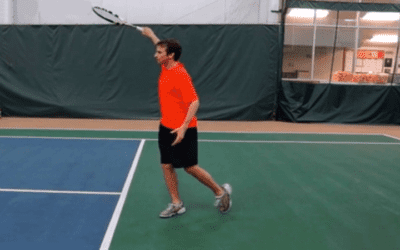6 Reasons To Perform The Glute Bridge Exercise
The glute bridge is one of the most powerful exercise you can add to your tennis training routine. Let’s get into the 6 reasons why you need to be performing this exercise on a regular basis.
The glutes are the strongest muscle in the body
Don’t you want to make sure the strongest muscle in the body is…well…strong.
That makes total sense, but most players actually don’t realize the glutes are the strongest muscles…plus they don’t train them enough. The glutes allow you to run faster, change direction easier, and create more force so that you can hit your shots with more power.
Strong glutes will balance out overdeveloped quad muscles
Most tennis players are quad dominant.
What does this mean?
If you’re a serious tennis player, you may know that your quadriceps muscles get super overdeveloped. When you are constantly in a low athletic position, your quads have to do a lot of work. The overuse of your quads creates an imbalance between the front side of your body and the back side (your glutes). Therefore, it becomes vitally important to train your glutes to offset the extra work that your quads get on the tennis court.
The glutes are a great core stabilizer
The glutes are actually considered a part of your core. Your core is not just your abdominal muscles. You need to focus on your rectus abdominis, obliques, hip flexors, low back muscles, and your glutes in order to stabilize and solidifying your core.
Strong Glutes Can Reduce Or Eliminate Lower Back Pain
If your glutes are weak and not activated they can’t do the work they were meant to do. As a result, your low back (lumbar spine) may have to work extra hard to compensate. Overuse of your low back muscles can lead to pain so make sure when you want strengthen your glutes to take stress of your lumbar spine

You can strengthen your glutes anywhere.
Because the glute bridge doesn’t require equipment, all you need is a floor or the ground to lay down on your back and bust out some reps. You can easily perform this exercise on the court, in a gym, at home, or in a hotel room. You can do glute bridges just about everyday but 2-3 times week is a great start. There are no excuses for not sticking with the glute bridge as part of your routine regardless of where you are.
You can easily progress to more advanced versions
Once you get the regular glute bridge down where you can do repeated reps with solid form, you can start to introduce more advanced versions. You can add time to your glute bridge holds (up to 20 seconds or more) to build endurance which is an important key to optimal performance on the court.. You can also progress to single leg progressions which are a lot more demanding than the double leg glute bridge exercises. After you get the form down for the single leg bridge, you can start to hold this progression for time to build endurance in each leg as well. Single leg glute bridges are very demanding but will deliver big time result on the court.
One word of caution….
Make sure you have great form and don’t progress to single leg glute bridges until you know that your technique is solid. Remember to avoid hyperextending you back to accomplish this exercise.



Thanks Jeff. So true. I do these exercises daily during my 10 minutes of pilates in the morning and can not start a day without it now. I find pilates an excellent way to work out, supplementary to playing tennis. Apart from relieving lower back pain, it helps me to improve my stability and flexibility on court.
Awesome, Amy! Thanks for sharing!
It’s simple, it’s versatile, and everyone who sits on their butt for hours or wants to be stronger and more powerful stands to benefit from it.
Yes, Anna!